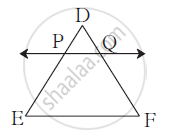Advertisements
Advertisements
Question
Find the equation of the line through the points A(–1, 3) and B(0, 2). Hence, show that the point A, B and C(1, 1) are collinear.
Solution
Slop of line AB = m =
Using the slope-point from, the equation of line AB is given by
y – y1 = m(x – x1)
i.e. y – 3 = –1[x – (–1)]
i.e. y – 3 = –1(x + 1)
i.e. y – 3 = –x – 1
i.e. x + y = 2
Now, slope of line BC =
Since, slope of line AB = slope of line BC.
Point A, B and C are collinear.
APPEARS IN
RELATED QUESTIONS
Given 3x + 2y + 4 = 0
(i) express the equation in the form y = mx + c
(ii) Find the slope and y-intercept of the line 3x + 2y + 4 = 0
Find the slope and y-intercept of the line:
3x – 4y = 5
Is the line 3x + 4y + 7 = 0 perpendicular to the line 28x – 21y + 50 = 0?
Is the line x – 3y = 4 perpendicular to the line 3x – y = 7?
Is the line 3x + 2y = 5 parallel to the line x + 2y = 1?
Find the equation of the perpendicular bisector of the line segment obtained on joining the points (6, −3) and (0, 3).
The line 4x − 3y + 12 = 0 meets x-axis at A. Write the co-ordinates of A. Determine the equation of the line through A and perpendicular to 4x – 3y + 12 = 0.
Find the point on the X–axis which is equidistant from A(–3, 4) and B(1, –4).
Verify that points P(–2, 2), Q(2, 2) and R(2, 7) are vertices of a right angled triangle.

In Δ DEF, line PQ || side EF, If DP = 2.4,
PE = 7.2, DQ = 1 then find QF.
